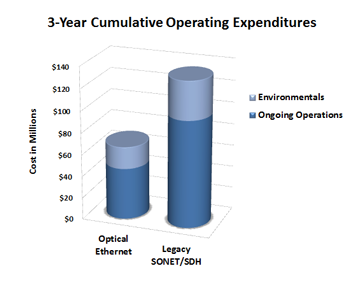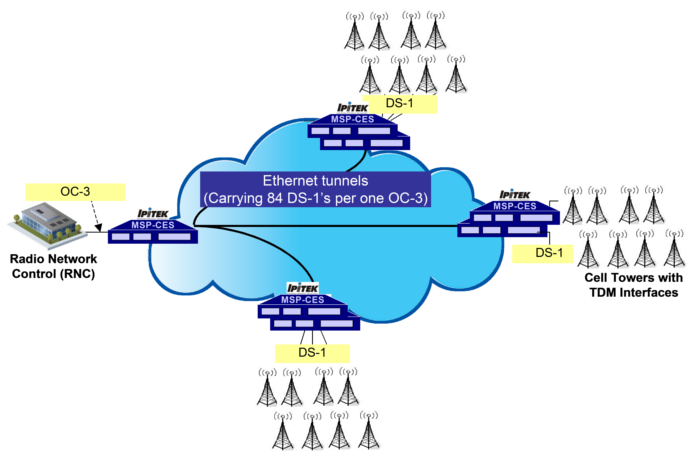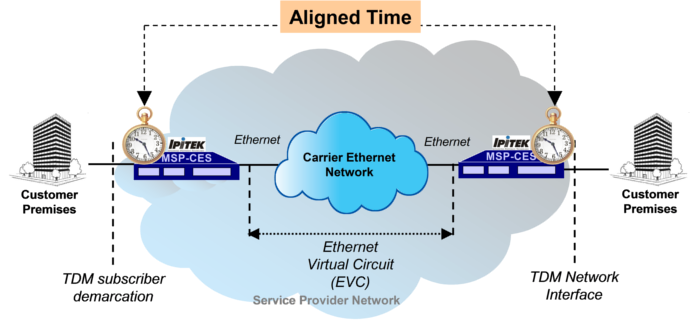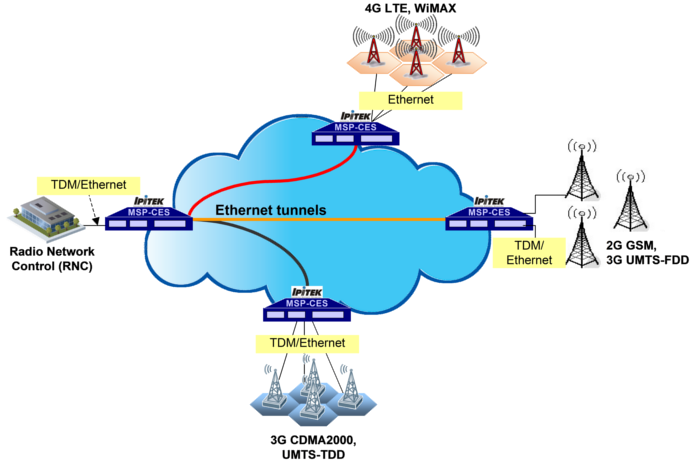
Login Form
Need help finding the perfect solution or services to fit your company's needs?
We have the answers!
Carry SONET/SDH Circuits over Ethernet
TDM Circuit Emulation Services over Ethernet (CESoETH) were developed so that carriers can offer premium priced legacy transport transparently over low cost modern networks. Carrier Ethernet is rapidly displacing high-priced, inflexible, old TDM technologies like SONET/SDH, ATM and Frame Relay in new access and metro network build-outs, because the worldwide deployment of LANs together with standardization has driven the price down considerably; for example, see the OPEX comparison in Figure 1. Nevertheless, a large existing customer base will continue to demand TDM service until their installed capital equipment passes its economic end-of-life. Carriers face the challenge of supporting legacy services over IP/Ethernet networks which are not optimized for constant bit rate traffic - such as voice, T1/E1 and T3/E3. These old transport formats currently provide the largest portion of telecom carrier revenues and it will remain this way for some time.
 |
| Figure 1: 3-Year Cumulative Operating Expenditures (Courtesy: Metro Ethernet Forum (MEF)) |
Circuit emulation is a technology that enables TDM traffic to be transported transparently over packet switched networks (PSN) including Ethernet, IP, and MPLS. Circuit emulation reduces both operational and capital expenditures (OPEX and CAPEX) by utilizing the flexibility and scalability of PSN to deliver a multi-service suite to businesses. Migrating TDM transport to PSN not only benefits the short term goal of reducing expenditures but also serves the carriers' long term migration plans to rollout new revenue generating packet-based services. Circuit Emulation Service over Ethernet complements the wide range of modern broadband data services offered over Carrier Ethernet networks.
A viable CESoETH architecture must effectively meet these fundamental challenges:
- Providing seamless integration with existing TDM protocols and signaling
- Ensuring that QoS is not degraded by packet delay and distortion
- And most importantly, providing efficient timing and synchronization
IPITEK meets these challenges through its MSP-CES (Circuit Emulation Service) solution, a highly integrated platform with enhanced QoS, operations management, and customization capabilities. The MSP-CES is a plug-and-play customizable solution. All service and transport capabilities are integrated into customer selectable removable cards. Card configurations include: (1) 4x T1/E1 ports, (2) 3x T3/E3 ports, and (3) a single OC-3/STM-1 interface. Note that TDM traffic is converted to Ethernet on the line card itself and sent via the backplane to the Ethernet card, where it is multiplexed with other data services and transported through a trunk port.
Our TDM service cards allow for multi-point TDM service interconnection and TDM-level aggregation. For example, the MSP-CES OC-3/STM-1 card supports user-selectable transparent mode (the OC-3/STM-1 signal is not de-multiplexed and analyzed) and channelized mode (the OC-3/STM-1 signal can be multiplexed into 84 VT1.5 sub-channels and analyzed). Using the channelized mode, one OC-3/STM-1 card located at a radio network control (RNC) center can be used to communicate with up to 84 cellular towers at various different locations as shown in Figure 2. Also, the MSP-CES T3/E3 card supports user-selectable transparent and channelized modes (the T3/E3 signal can be multiplexed into the corresponding T1/E1 signals).

Figure 2: Mobile Backhaul Example: Supporting Multiple Cellular T1/E1-based Towers Using One OC-3/STM-1 Card at RNC
As part of our DNA for highly integrated solutions, smallest footprints & highest performance, we developed the MSP-CES as a highly customizable solution that can be deployed in various network segments. The MSP-CES TDM cards can be replaced with all Ethernet cards. In addition, the MSP-CES Ethernet main transport, which conventionally runs at 1GE rate, can be replaced with a 10GE rate card. Note that upgrading from a 1GE platform to a 10GE platform is as simple as swapping out the line cards. This dynamic and highly customizable configuration enables seamless optimization and upgrade of any MSP-CES unit, allowing it to function at any position in the network, from access to metro to core, while supporting hybrid service and transport options.
TDM encapsulation into Ethernet follows MEF-8 and MEF-18 specifications for CESoETH. CESoETH provides physical layer extension over Ethernet, which makes the system transparent to protocols and signaling. This is accomplished by maintaining the integrity of framed or unframed T1/E1s and by providing support for cross network clock regeneration. Naturally, standard T1/E1 interfaces are provided that are compatible with ports on existing PBXs and circuit switches.
Another challenge is providing QoS that is comparable to what is currently provided by the legacy TDM infrastructure. QoS is the ability of a network to assure that it can meet traffic and service requirements. QoS performance criteria include network downtime, network error performance, lost transmissions, fault detection, and recovery. A key element of QoS is the ability to provide service contracts for time sensitive traffic. Although this goal is at odds with the basic principles of Ethernet, which has no mechanism for clock synchronization or recovery, QoS techniques exist outside of the Ethernet standard to overcome this limitation. These techniques include prioritization, tagging, traffic shaping, buffering, bandwidth reservation and management. Carrier-class operation on the Ethernet side also contributes to meeting the QoS challenge: Ethernet Protection including Ethernet Ring Protection (ERP) per ITU-T 8031, Rapid Spanning Tree Protocol (RSTP), and Point-to-Point (P2P); support for Chassis and Card protection/redundancy; Ethernet OAM by IEEE 802.1ag Connection Fault Management (CFM), ITU-T Y.1731 Performance Monitoring (PM), and IEEE 802.3ah (Ethernet in the last mile).
Timing and Synchronization
The most important challenge is timing and synchronization. In supporting TDM over packet networks such as CESoETH, service or network synchronization is a real challenge. In a TDM network, the timing clock signal is transported natively over the network, but with a packet-based transport network that is asynchronous in nature (see Figure 3), it is a necessity to develop mechanisms to transport the clock in a very accurate and reliable manner with minimum bandwidth consumption. These mechanisms need to overcome packet-based network issues, such as varying delay, jitter and packet loss.

Figure 3: The Need for Aligned Synchronization for Efficient TDM Circuit Emulation
Synchronization is also necessary for fault-free operation of various end applications; particularly, mobile wireless networks. This is because the radio used in these networks operates in very strict bands that need separation to avoid channel interference which reduces call quality and network capacity. In addition, poor synchronization has a negative impact on the handover between Base Stations (i.e., when the cell phone of a moving end-user reconnects from one cell tower to another tower based on communication signal strength). Mobile handsets derive the frequency that they transmit from what they receive from the Base Stations. If the transmission frequencies are not very closely matched between adjacent cell sites, then "clicks" can occur when the call is switched between Base Stations. In the worst case, the call would drop because the mobile handset would not be able to immediately lock onto and acquire the new signal.
In general, radio-based networks (such as mobile wireless backhaul, see Figure 4) fall into two categories, Frequency Division Duplexing (FDD) and Time Division Duplexing (TDD), both of which require frequency synchronization in order to accurately send and receive traffic. FDD networks use two sets of frequencies for transmit/receive. TDD networks use a single frequency for transmit/receive and a demarcation based on timeslots is identified for both transmission and reception. TDD networks have the additional requirement of precise time synchronization.

Figure 4: MSP-CES Supporting Various Mobile Technologies
Given the various and challenging synchronization requirements for different applications, IPITEK's MSP-CES supports two basic categories of synchronization solutions:
- Network synchronous methods (that is, reference timing signal distributed over the synchronous physical layer). IPITEK MSP-CES achieves that by supporting Synchronous Ethernet (Sync-E) on any of its Ethernet ports. Enabling Sync-E on any port is user selectable.
- Packet-based methods: Packet-Timing Protocol (PTP) such as IEEE1588v2 belongs to this category. IPITEK achieves that by using its ultra-small standalone IEEE1588v2-based platform, the MSP-1588, to provide synchronization. The MSP-1588 supports all telecom-profile modes of operation including master, slave, and transparent (timing repeater). The beauty of the standalone solution is that it allows for building extremely accurate user-customizable and upgradable network timing "overlays" that perfectly fit end user applications from mobile backhaul to TDM business services to PBX interconnection, wherever needed, whenever needed.
In carrying out its function, the MSP-CES relies on internal oscillators: TCXO, OCXO, Stratum 3, or Stratum 3E quality clocks as specified at time of purchase. The systems timing module can also be driven by an external input entering on the BITS interfaces. When Synch-E mode is selected at an Ethernet port, the clock signal received on that port could be used to drive the system's timing module. For the T1/E1 ports, adaptive clock recovery method is used to extract the clock from the incoming Ethernet stream. Loop timing can also be used where the clock is derived by the TDM interface from the customer equipment attached to that interface.
Summary
IPITEK's MSP-CES has the capabilities for supporting all types of applications, including all mobile technologies. This is achieved by IPITEK's Highly integrated solution philosophy that provides a wide range of services, access media, transport options, and synchronization capabilities for the most synchronization-stringent applications.

© 2012 Integrated Photonics Technology, Inc. All rights reserved.



